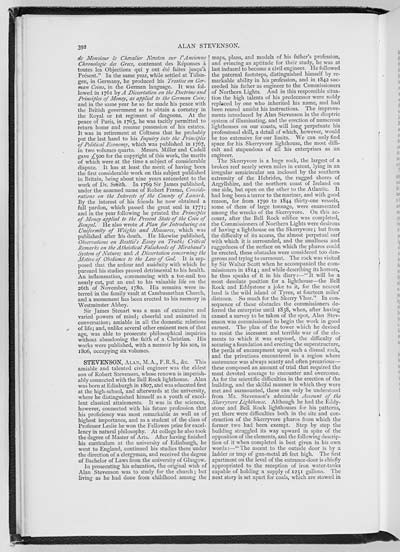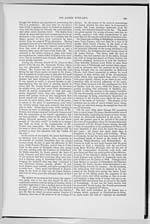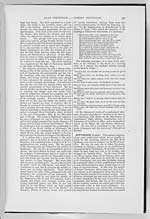Volume 3 > Half-Volume 6
(38) Page 392 - Stevenson, Alan
Download files
Individual page:
Thumbnail gallery: Grid view | List view

392 de Monsieur le Chevalier Newton sur l'Ancienne Chronologie des Grecs, contenant des Reponses a toutes les Objections qui y ont �t� faites jusqu'� Present." In the same year, while settled at Tubin- gen, in Germany, he produced his Treatise on Ger- man Coins, in the German language. It was fol- lowed in 1761 by A Dissertation on the Doctrine and Principles of Money, as applied to the German Coin; and in the same year he so far made his peace with the British government as to obtain a cornetcy in the Royal or 1st regiment of dragoons. At the peace of Paris, in 1763, he was tacitly permitted to return home and resume possession of his estates. It was in retirement at Coltness that he probably put the last hand to his Inquiry into the Principles of Political Economy, which was published in 1767, in two volumes quarto. Messrs. Miller and Cadell gave �5OO for the copyright of this work, the merits of which were at the time a subject of considerable dispute. It has at least the merit of having been the first considerable work on this subject published in Britain, being about nine years antecedent to the work of Dr. Smith. In 1769 Sir James published, under the assumed name of Robert Frame, Conside- rations on the Interests of the County of Lanark, By the interest of his friends he now obtained a full pardon, which passed the great seal in 1771; and in the year following he printed the Principles of Money applied to the Present State of the Coin of Bengal. He also wrote A Plan for Introducing an Uniformity of Weights and Measures, which was published after his death. He likewise published, Observations on Seattle's Essay on Truth; Critical Remarks on the Atheistical Falsehoods of Mirabaud's System of Nature; and A Dissertation concerning the Motive of Obedience to the Law of God. It is sup- posed that the ardour and assiduity with which he pursued his studies proved detrimental to his health. An inflammation, commencing with a toe-nail too nearly cut, put an end to his valuable life on the 26th of November, 1780. His remains were in- terred in the family vault at Cambusnethan Church, and a monument has been erected to his memory in Westminster Abbey. Sir James Steuart was a man of extensive and varied powers of mind; cheerful and animated in conversation; amiable in all the domestic relations of life; and, unlike several other eminent men of that age, was able to prosecute philosophical inquiries without abandoning the faith of a Christian. His works were published, with a memoir by his son, in 1806, occupying six volumes. STEVENSON, ALAN, M. A., F. R. S., &c. This amiable and talented civil engineer was the eldest son of Robert Stevenson, whose renown is imperish- ably connected with the Bell Rock lighthouse. Alan was born at Edinburgh in 1807, and was educated first at the high-school, and afterwards at the university, where he distinguished himself as a youth of excel- lent classical attainments. It was in the sciences, however, connected with his future profession that his proficiency was most remarkable as well as of highest importance, and as a student of the class of Professor Leslie he won the Fellowes prize for excel- lency in natural philosophy. At college he also took the degree of Master of Arts. After having finished his curriculum at the university of Edinburgh, he went to England, continued his studies there under the direction of a clergyman, and received the degree of Bachelor of Laws from the university of Glasgow. In prosecuting his education, the original wish of Alan Stevenson was to study for the church; but living as he had done from childhood among the maps, plans, and models of his father's profession, and evincing an aptitude for their study, he was at last induced to become a civil engineer. He followed the paternal footsteps, distinguished himself by re- markable ability in his profession, and in 1842 suc- ceeded his father as engineer to the Commissioners of Northern Lights. And in this responsible situa- tion the high talents of his predecessor were nobly replaced by one who inherited his name, and had been reared amidst his instructions. The improve- ments introduced by Alan Stevenson in the dioptric system of illuminating, and the erection of numerous lighthouses on our coasts, will long perpetuate his professional skill, a detail of which, however, would be too extensive for our limits. We can only find space for his Skerryvore lighthouse, the most diffi- cult and stupendous of all his enterprises as an engineer. The Skerryvore is a huge rock, the largest of a broken reef nearly seven miles in extent, lying in an irregular semicircular sea inclosed by the southern extremity of the Hebrides, the rugged shores of Argyllshire, and the northern coast of Ireland on one side, but open on the other to the Atlantic. It had long been a terror to the mariner, and with good reason, for from 1790 to 1844 thirty-one vessels, some of them of large tonnage, were enumerated among the wrecks of the Skerryvore. On this ac- count, after the Bell Rock edifice was completed, the Commissioners of Northern Lights were desirous of having a lighthouse on the Skerryvore; but from the difficulty of its access, the almost perpetual surf with which it is surrounded, and the smallness and ruggedness of the surface on which the pharos could be erected, these obstacles were considered too dan- gerous and trying to surmount. The rock was visited by Sir Walter Scott when he accompanied the com- missioners in 1814; and while describing its horrors, he thus speaks of it in his diary:�"It will be a most desolate position for a lighthouse�the Bell Rock and Eddystone a joke to it, for the nearest land is the wild island of Tyree, at fourteen miles' distance. So much for the Skerry Vhor." In con- sequence of these obstacles the commissioners de- ferred the enterprise until 1838, when, after having caused a survey to be taken of the spot, Alan Stev- enson was commissioned to begin the work in good earnest. The plan of the tower which he devised to resist the incessant and terrible war of the ele- ments to which it was exposed, the difficulty of securing a foundation and erecting the superstructure, the perils of encampment upon such a dismal rock, and the privations encountered in a region where sustenance was always scanty and often precarious� these composed an amount of trial that required the most devoted courage to encounter and overcome. As for the scientific difficulties in the erection of the building, and the skilful manner in which they were met and surmounted, these can only be understood from Mr. Stevenson's admirable Account of the Skerryvore Lighthouse. Although he had the Eddy- stone and Bell Rock lighthouses for his patterns, yet there were difficulties both in the site and con- struction of the Skerryvore pharos from which the former two had been exempt. Step by step the building struggled its way upward in spite of the opposition of the elements, and the following descrip- tion of it when completed is best given in his own words:�"The ascent to the outside door is by a ladder or trap of gun-metal 26 feet high. The first apartment on the level of the entrance-door is chiefly appropriated to the reception of iron water-tanks capable of holding a supply of 1251 gallons. The next story is set apart for coals, which are stowed in
Set display mode to:
![]() Universal Viewer |
Universal Viewer | ![]() Mirador |
Large image | Transcription
Mirador |
Large image | Transcription
Images and transcriptions on this page, including medium image downloads, may be used under the Creative Commons Attribution 4.0 International Licence unless otherwise stated. ![]()
| Biographical dictionary of eminent Scotsmen > Volume 3 > Half-Volume 6 > (38) Page 392 - Stevenson, Alan |
|---|
| Permanent URL | https://digital.nls.uk/74514350 |
|---|---|
| Attribution and copyright: |
|
| Description | Volume III. Contains names alphabetically from Macadam to Young. |
|---|

